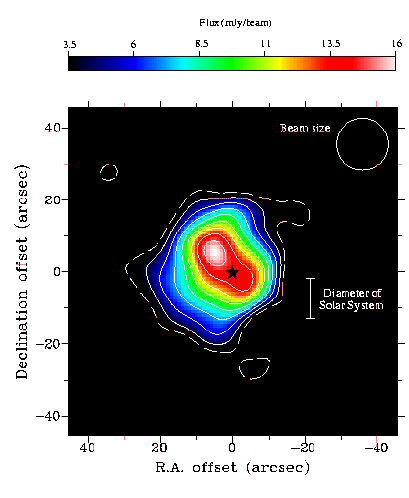
Image credit: Holland, W. S., Greaves, J. S., Zuckerman, B., et al. 1998, "Submillimetre images of dusty debris around nearby stars", Nature, vol. 392, pg. 788 Copyright, please do not reproduce without permission from the authors.
Vega at 850 microns
HD 172167 HR 7001
alfa Lyra HIP 91262
RA (2000) = 18 36 56.3364
Dec (2000) = +38 47 01.291
SpT = A0V
V = 0.03 mag d = 7.756 pc
Proper Motion (mas/yr) = +201.03 +287.47
This image of Vega essentially traces the thermal
emission of dust. Notice that the black star
represents the location of the star. The
white peak to the northeast of the star represents
the peak of dust emission.
Vega is the brightest star in the Northern Hemisphere
and in 1983 was the first nearby star
observed to possess orbiting solid material.
Researchers using data from IRAS (Infrared
Astronomical Satellite) deduced that the dust
was in a ring approximately 80 AU from
the star with grains larger than 10 microns in
diameter.
The 850 micron image confirms extended thermal
emission from dust around the star.
The
big surprise is that the dust doesn't appear
to be an azimuthally symmetric ring because there is a distinct peak
of thermal emission 5.9" East and 7.1" North
of the star (a minimum distance of 72 AU).
Dent et al. (2000) model the SCUBA image above
with a dust ring that has inner and outer radii of
80 AU and 120 AU, respectively. Because the ring is
viewed 15 degrees away from face-on, the vertical
thickness of the disk is projected into the sky, and
cannot be easily measured. From analysis of the spectral
energy distribution (SED) the grain temperature is 80 K, with
characteristic size 70 microns, though a range of size
between 30 and 200 microns is consistent with the data.
The lack of significant short-wavelength excess thermal
emission suggests that 10 micron sized grains must
have cumulative mass <10 percent that of the 70 micron
grains.
The total dust mass
is estimated between 0.2-0.7 lunar masses.
The Dent et al. (2000) constraints on dust size and location
can be used to calculate the lifetime of grains. They find that
Poynting-Robertson drag would destroy 70 micron sized grains at
80 AU in 20 Myr, but grain-grain collisions at 80 AU would
destroy these grains in 500,000 yr. Therefore collisions are the most
significant process that destroys grains. If the age of Vega is 300 Myr,
then the 70 micron grains observed with SCUBA have been
replenished 600 times over. The source of replenishment
is thought to be collisions of larger dust grains or planetesimals.
These objects are a parent population of primordial bodies that
can survive up to the present age of the star. Dent et al.
estimate that objects larger than 0.38 cm in size replenish the
observed 70 micron grains.
Basic facts about Vega:
1) age is estimated to be between 310 Myr and 390 Myr
2) structure is a ring with inner and outer radii of 80 and 120 AU, respectively.
3) characteristic grain size is 70 microns, with characteristic temperature 80 K.
4) total dust mass estimates between 0.2-0.7 lunar mass,
i.e. (1.5-5.1)x10^25 g or (7.5-26)x10^-9 M_sun
5) morphology is significantly asymmetric
6) ring is seen near face-on from our point of view. This
orientation is also
derived from Vega's low projected rotational velocity of 22 km/s.